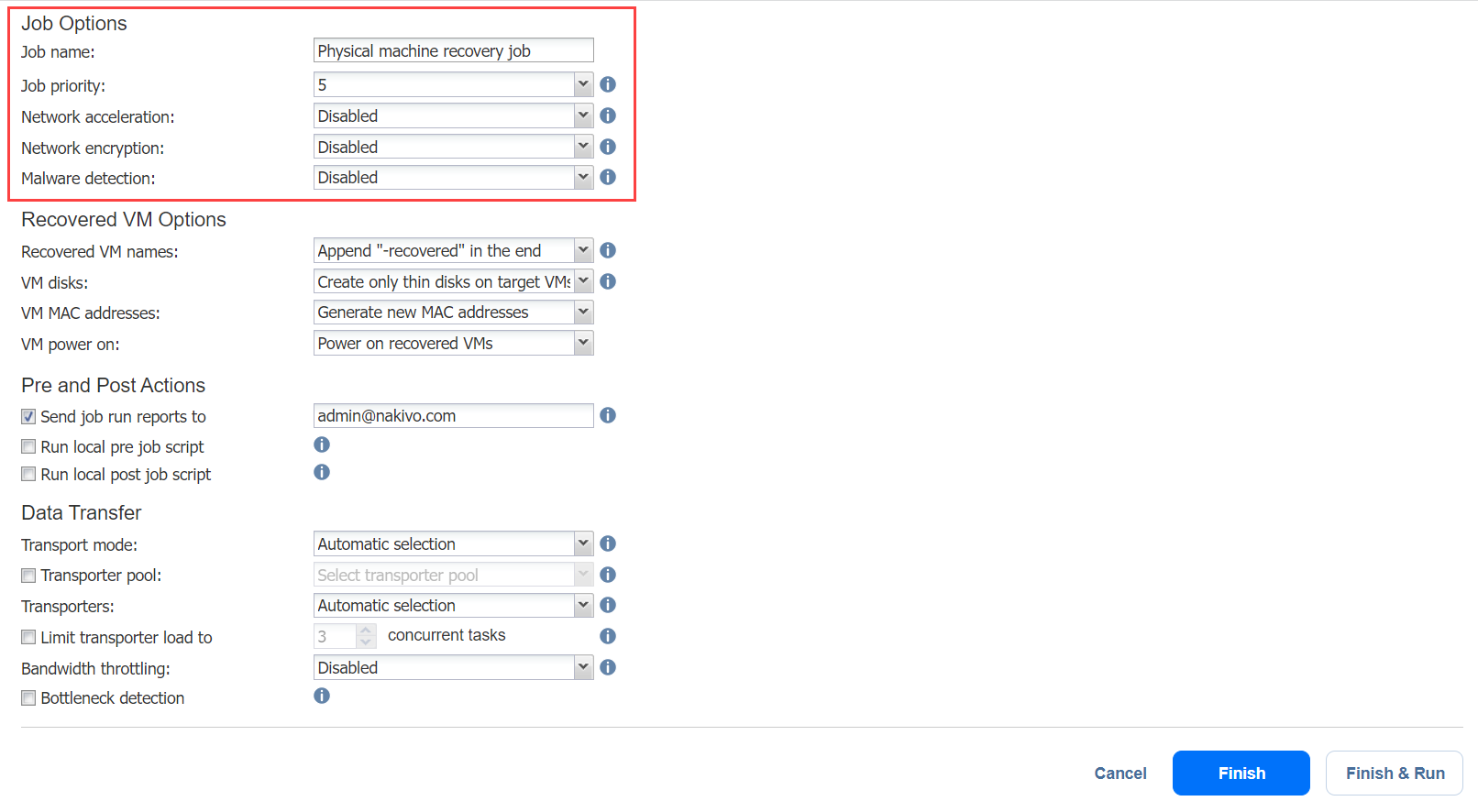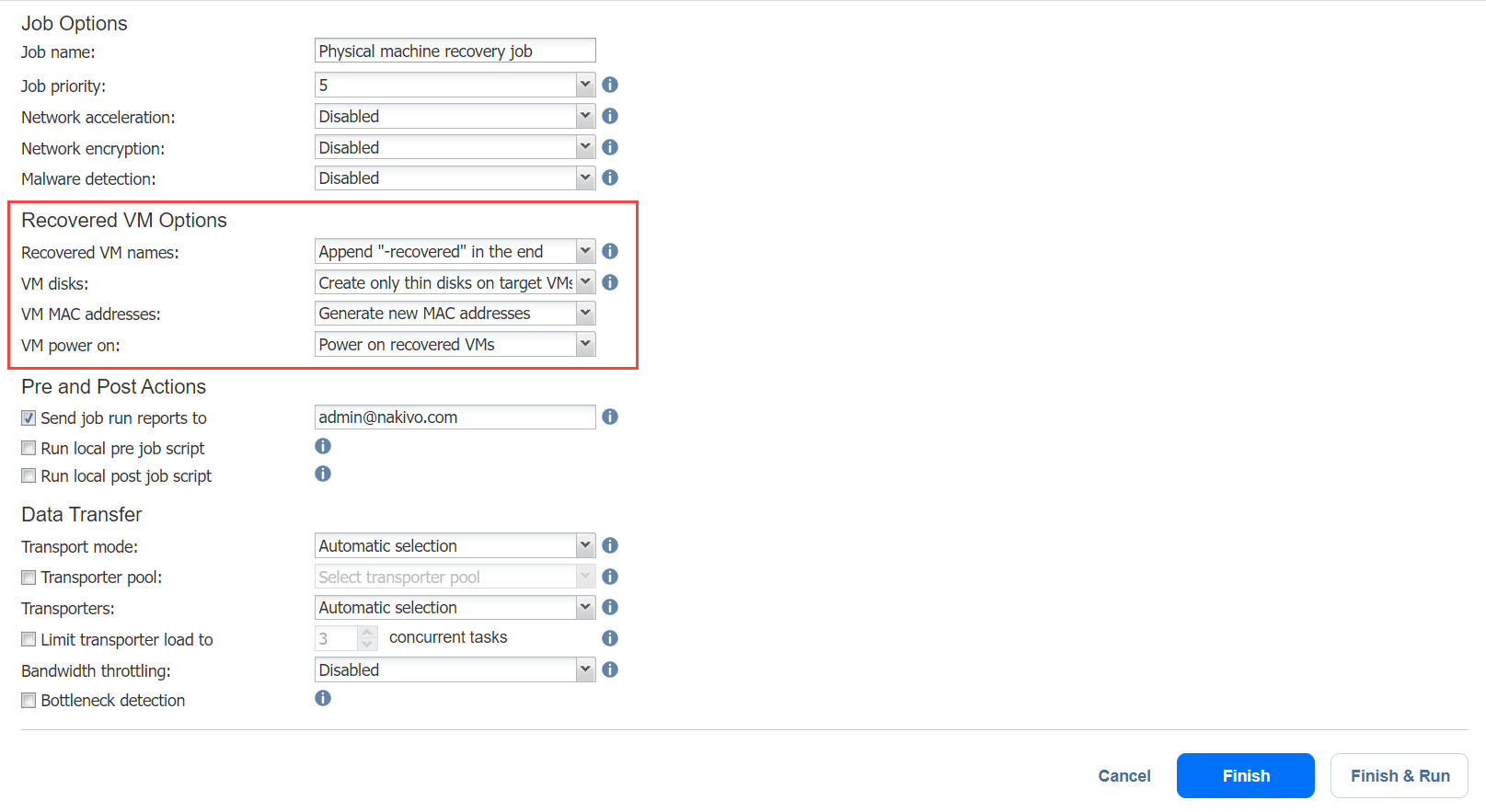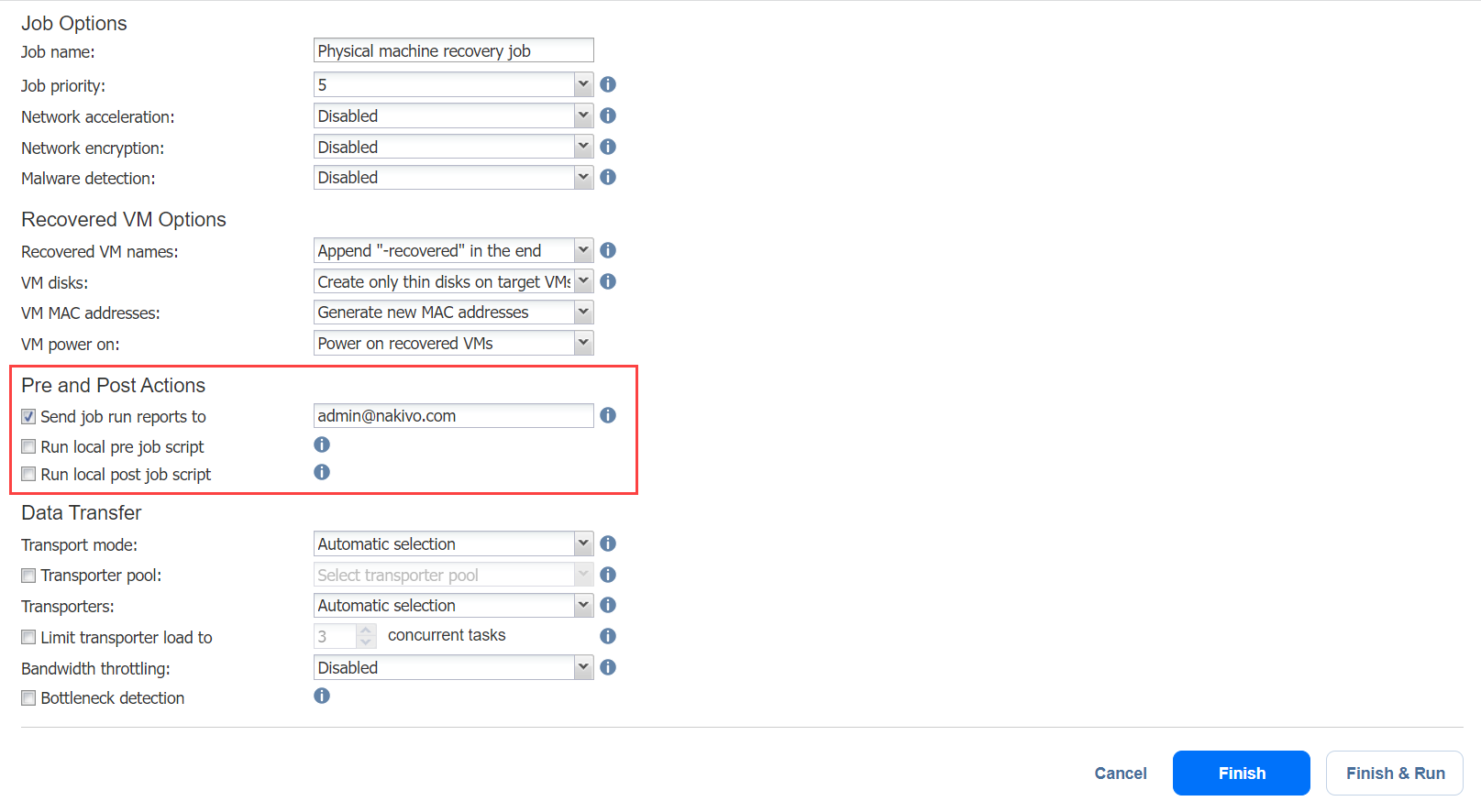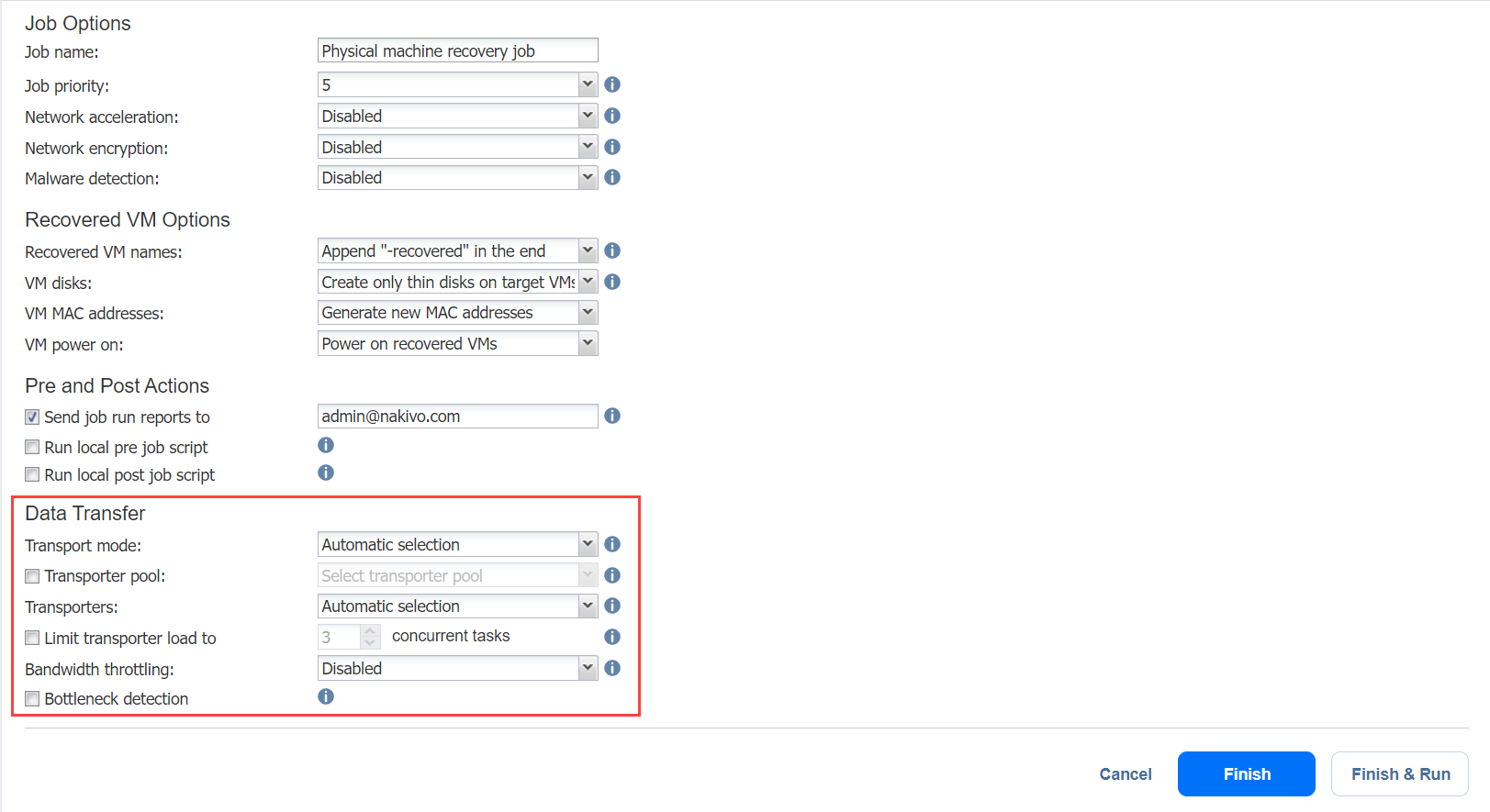Recovery Job Wizard for Physical Machines: Options
On the Options page, set the options for the physical machine recovery job.
Job Options
In the Job Options section, set the following:
-
Job name: Enter the name for the recovery job.
-
Job priority: Select a job priority level between 1 and 5, with 1 being the highest priority. Jobs with higher priority levels are prioritized by Transporters during job processing.
Note
This option is only available in the Enterprise, Enterprise Essentials, Enterprise Plus, MSP Enterprise, and MSP Enterprise Plus editions. -
Network acceleration: Enable network acceleration if you transfer data over a slow WAN. Note that you need at least one Transporter on source and target sites for this feature to work.
-
Network encryption: Enable network encryption to protect your data while transferring it over a WAN without VPN. Job data will be encrypted during the transfer that will increase the load on the Transporter(s).
- Malware detection: With this option enabled, the backups are scanned for malware using the configured antivirus software on the scan server.
-
Optionally, if you have selected Enabled for the Malware detection option, click the settings link to configure the following options:
-
Scan server: Select a specific scan server for the job or leave the Default setting. If Default is selected, the Transporter is used as the scan server and can support a maximum of 2 concurrent scan tasks.
Notes
-
For the Default option, if the Repository Transporter is the installed Transporter, it require the master password to function as the scan server.
-
For more details on the requirements for Scan Server, refer to the Feature Requirements.
-
-
Scan type: Choose between the Deep scan and the Quick scan:
-
Deep scan: When this option is selected, the antivirus software scans the entire backup and may take longer to complete.
-
Quick scan: When this option is selected, the antivirus software scans only OS disks in the backup.
-
-
If malware is detected: Choose the behavior if malware is detected:
-
Fail the recovery job: With this option, the recovery process fails in case the job has only one machine. If the job has several machines, the infected machines are skipped and the job continues to run.
-
Continue and recover to isolated network: When this option is selected, the recovery job completes the scanning process and recovers the infected machines to a temporary isolated network.
-
-
Scan timeout: Specify the timeout for the malware detection process. If the specified amount of time is exceeded, the recovery job fails.
-
Click Apply when you’re done.
-
Recovered VM Options
In the Recovered VM Options section, set the following:
-
Recovered VM names: Select one of the following VM name options:
-
Append "-recovered" in the end: Select this option to use the name of the source physical machine for the recovered VM name with -recovered added to the in the end.
-
Leave recovered VM names as is: Select this option to retain the name of the source physical machine for the recovered VM name.
-
Enter custom recovered VM names: Select this option specify a custom name for the recovered VM.
-
-
VM disks: Select one of the following VM disk types:
-
Respect original VM disk type: Select this option to keep the same disk type as the source machine for the recovered VM.
-
Create only thin disks on target VMs: Select this option to create thin disks on your target VM.
-
-
VM MAC addresses: Select one of the following actions for the recovered VM:
-
Generate new MAC addresses
-
Do not generate new MAC addresses
-
-
VM power on: Select one of the following options:
-
Power on recovered VMs
-
Do not power on recovered VMs
-
Pre and Post Actions
In the Pre and Post Actions section, set the following actions after the recovery job is completed:
-
Send job run reports to: Enter one or more email addresses in the text field. Use semicolons to separate multiple email addresses.
Note
To enable this option, make sure that Email settings are configured. -
Run local pre job script: To run a script after the product has finished the recovery job, do the following:
-
Place a script file on the machine on which the Director is installed.
-
Select the Run local pre job script option and click the settings link.
-
Specify the following options in the dialog box that appears:
-
Script path: Specify a local path to the script on the machine where the Director is installed. A script interpreter should be specified.
Example (Windows): cmd.exe /c D:\script.bat -
Job behavior: Select one of the following job behaviors in relation to script completion:
-
Wait for the script to finish: When selected, the job remains in the “running” state until the script is executed.
-
Do not wait for the script to finish: When selected, the product runs the script and starts the recovery process at the same time.
-
-
Error handling: Select one of the following job behaviors in relation to script failure:
-
Continue the job on script failure: When selected, script failure does not influence the status of the job.
-
Fail the job on script failure: When selected and the script fails, the job status is set to “failed” and recovery is not performed.
-
-
-
-
Run local post job script: To run a script after the product has finished the recovery process, do the following:
-
Place a script file on the machine on which the Director is installed.
-
Select the Run local post job script option and click the settings link.
-
Specify the following options in the dialog box that appears:
-
Script path: Specify a local path to the script on the machine on which the Director is installed. A script interpreter should be specified.
Example (Windows): cmd.exe /c D:\script.bat -
Job behavior: Select one of the following job behaviors in relation to script completion:
-
Wait for the script to finish: When selected, the job remains in the “running” state until the script is executed.
-
Do not wait for the script to finish: When selected, the job is completed even if the script execution is still in progress.
-
-
Error handling: Select one of the following job behaviors in relation to script failure:
-
Continue the job on script failure: When selected, script failure does not influence the status of the job.
-
Fail the job on script failure: When selected and the script execution fails, the job status is set to “failed” even if the recovery process is successful.
-
-
-
Data Transfer
Transport Mode
NAKIVO Backup & Replication provides the following transport modes for writing VM data:
-
Automatic: When this option is chosen, Hot Add mode is used where possible. If the product cannot use Hot Add, LAN mode is used.
-
Hot Add only: NAKIVO Backup & Replication can write data directly to the datastore bypassing the network, which can significantly increase the job performance. This is achieved with the help of VMware's Hot Add technology. In order for the Hot Add feature to work, the target Transporter (the one that will be writing data) should run on a host that has access to the target datastore(s).
-
LAN only: Data will be written over LAN.
Transporter Pool
If this option is enabled, only the transporters that belong to the selected transporter pool shall be used during the job run.
Transporters
By default, the product automatically determines which Transporter should be used to read data from the source VM. However, you can manually specify which Transporters should be used for the job:
-
Automatic selection: The product automatically determines the Transporters that are the closest to source and target hosts.
-
Manual - configured for all VMs: Select this option to manually specify a single source and a single target Transporter that will be used for data transfer by the job.
-
Manual - configured per host: Select this option to manually specify Transporters for all source and target hosts.
Transporter Load
You can limit the maximum number of transporter tasks used by the job. By default, this number is set to 3 concurrent tasks. To change the default number of tasks, do the following:
-
In the Data Transfer section, select the Limit transporter load to checkbox.
-
Specify the number of concurrent tasks in the corresponding box.
Bandwidth Throttling
Follow the steps below to set the speed of data transfer over the network for your recovery job:
-
For the Bandwidth throttling option, choose Enabled.
Note
If bandwidth throttling is disabled for the current job, global bandwidth rules may still apply to your job. Refer to Bandwidth Throttling for details. -
Click the settings link that becomes available.
-
The Job Bandwidth Rules dialog box opens displaying the list of available rules. You have the following options:
-
Create a new bandwidth rule for your recovery job:
-
Click the Create New Rule button.
-
The New Bandwidth Rule dialog opens. Refer to Bandwidth Throttling for details on creating a bandwidth rule.
-
Click Save.
-
-
Activate an existing bandwidth rule for your job: Select the checkbox to the left of the required bandwidth rule. To deactivate a bandwidth rule for your job, deselect the corresponding checkbox.
-
Edit a bandwidth rule: Click the Edit link for a bandwidth rule and modify it in the Edit Bandwidth Rule dialog box that opens.
-
Disable a bandwidth rule: Click the Disable link. The bandwidth rule is disabled for all jobs.
-
Remove a bandwidth rule: Click the Remove link and then click Delete to confirm your operation.
-
Bottleneck Detection
When the Bottleneck detection option is enabled, additional information is collected and recorded in NAKIVO Backup & Replication logs in the course of data transfer for the purpose of bottleneck detection. Check this option to enable the Bottleneck detection capability of the Transporters engaged in the job.



